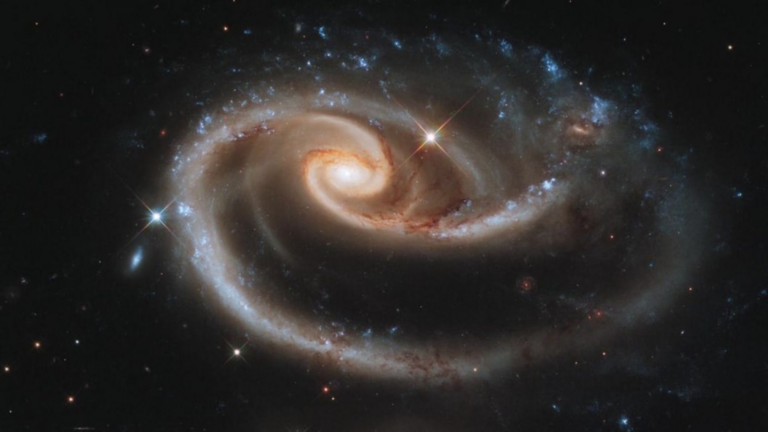
[ad_1]
The universe is a mystery, and space agencies like the National Aeronautics and Space Administration (NASA) help us understand it better. The US space agency constantly shares images and videos from space to bring common people closer to celestial objects and other bodies.
Here are top 10 NASA images that will provide you a rare glimpse of space to unlock its mysteries:

View Full Image
(ESA/Hubble & NASA)
Millions of light-years away in the small, northern constellation Canes Venatici, the spiral Sunflower galaxy (Messier 63) spreads its many arms – or so it seems. The Sunflower galaxy is a flocculent spiral galaxy. That means its spiral arms aren’t well defined, so it looks like there are many that appear to be winding around its yellow core. In reality, there are just two. The arms shine bright thanks to recently formed, blue–white giant stars.

View Full Image
This cosmic nebula, a cloud of gas and dust where new stars are born, was spotted by orbiting by NASA Hubble telescope. Located just over 5,300 light-years from Earth, this nebula is home to a number of young, developing stars called protostars, which show up as some of the smaller sparkles in this image. This particular nebula is rich with hydrogen ions which are excited by the ultraviolet radiation coming from the nebula’s protostars, giving it the pinkish glow seen here.

View Full Image
NGC 2005: It’s a glittery star cluster – a globular cluster – and it’s kinda weird. NGC 2005’s stars have a chemical composition that is distinct from the stars around it in the Large Magellanic Cloud (LMC), the Milky Way’s largest satellite galaxy. This suggests that the LMC underwent a merger with another galaxy somewhere in its history. That other galaxy has long-since merged and otherwise scattered, but NGC 2005 remains as an ancient witness to the merger.

View Full Image
A young star-forming region is filled with wispy orange, red, and blue layers of gas and dust. The upper left corner of the image is filled with mostly orange dust, and within that orange dust, there are several small red plumes of gas that extend from the top left to the bottom right, at the same angle. The center of the image is filled with mostly blue gas. At the center, there is one particularly bright star, that has an hourglass shadow above and below it. To the right of that is what looks a vertical eye-shaped crevice with a bright star at the center. The gas to the right of the crevice is a darker orange. Small points of light are sprinkled across the field, brightest sources in the field have extensive eight-pointed diffraction spikes that are characteristic of the Webb Telescope.

View Full Image
Messier 94: A cosmic crossover that goes beyond the ice rink – and into space! Captured here by NASA Hubble, the spiral galaxy M94 is located about 16 million light-years away in the constellation Canes Venatici. It belongs to the Messier catalog, a stargazing resource first compiled by the French astronomer Charles Messier in the 1700s.

View Full Image
In a patch of the autumn sky that contains the constellations Perseus, Andromeda, and Triangulum, a beautiful interaction is happening. A larger spiral galaxy (UGC 1810) is pulled on by its smaller companion galaxy, distorting it into a rose-like shape. The uncommon spiral patterns in the larger galaxy are a telltale sign of interaction. The large, outer arm appears partially as a ring, a feature seen when interacting galaxies actually pass through one another. This suggests that the smaller companion dived deep, but off-center, through UGC 1810.

View Full Image
This image of the Southern Ring Nebula was one of the very first that the James Webb Space Telescope shared with the world back in 2022. Officially known as NGC 3132, the Southern Ring Nebula is a cloud of gas and dust surrounding a dying star 2,500 light-years from Earth.

View Full Image
This delicate red ribbon crossing the cosmos is a remnant of a supernova that was viewed by humans 1,000 years ago from 7,000 light-years away. The name of this stellar explosion is SN 1006, and was observed in 1006 AD. It would have been the brightest star ever seen by humans—so bright that it could be seen during the daytime.

View Full Image
Barred spiral galaxy NGC 4731: Located 43 million light-years away in the constellation Virgo, this stunning sight showcases billowing clouds of gas, bright pink star-forming regions, and a luminous central bar. Barred spiral galaxies, like this one, make up about 60% of all galaxies.

View Full Image
Officially known as 30 Doradus, this star-forming region is nicknamed the Tarantula Nebula for its long, intricate filaments of dust. It’s the largest and brightest such region near our Milky Way galaxy—and it’s home to some of the hottest, most massive stars we’ve ever observed.
3.6 Crore Indians visited in a single day choosing us as India’s undisputed platform for General Election Results. Explore the latest updates here!
Download The Mint News App to get Daily Market Updates.
Published: 30 Jun 2024, 02:21 PM IST
[ad_2]